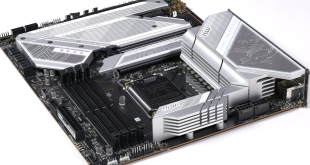On the right side of the memory module positions are some clever additions to the Rampage. Ever wanted to disable a graphics card without taking it out of the slot? Asus has added a switch to each PCI-Express slot which allows you to toggle it on and off. Apart from hardcore benchmarkers, We're not sure exactly how useful it will be, but it's a cool feature. Next to this are voltage readout positions for using your voltmeter – again ideal for monitoring droops and peaks without software in the mix. A Q reset compliments the power and reset buttons on the opposite side of the board. To cater for the hardcore guys into Liquid Nitrogen there is a LN2 mode jumper … to avoid cold boot bugs.
There is enough space around the socket to cater for the biggest of CPU heat sink configurations …
… this is a good thing as this is exactly what the target audience demands. All our cooling blocks fitted without a problem so unless you have modded a part of your cars engine into a homebrew CPU cooler then you won't have a problem. Serious overclockers will be happy to know that this board can take any cooling arrangement (Coolermaster V10 owners breathe a sigh of relief!).
The board has 8 SATA ports, located at the bottom right hand side of the layout – at right angles to the axis of the PCB. Think ‘ease of use'.
This is an intentional design to stop physical interference with graphics cards, but it also means that you need a little extra room in the hard drive chassis area for fitting. Two of the connectors are 6Gbps and are powered by the onboard Marvell controller.
This is an intentional design to stop physical interference with graphics cards, but it also means that you need a little extra room in the hard drive chassis area for fitting. Two of the connectors are 6Gbps and are powered by the onboard Marvell controller.
The back of the board offers more connectivity than an international airport. First up, there are 9 (yes 9!) USB ports – alongside Firewire, Gigabit Lan, eSata Port, PS2 keyboard port (rare nowadays) and a range of audio connectors. With future-proofing in mind, two of these USBs are 3.0 capable (NEC chipset). Optical SPDIF is a welcome addition for movie theater lovers and the obligatory surround connectors are present. I was happy to see three buttons on the I/O panel – the first clears the CMOS with the other two handling ROG Bluetooth connection and ROG connect.
In a rather unusual move we noticed that Creative XFI was omitted and when we asked Asus representative Iain Bristow, he said: “Due to the nature of the board and it's focus on extreme overclockers the decision was made to remove the X-FI solution and use a simpler offering. This in turn makes the performance at the highest end, even better”. Fair enough Iain!
 KitGuru KitGuru.net – Tech News | Hardware News | Hardware Reviews | IOS | Mobile | Gaming | Graphics Cards
KitGuru KitGuru.net – Tech News | Hardware News | Hardware Reviews | IOS | Mobile | Gaming | Graphics Cards





